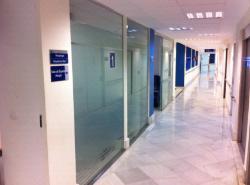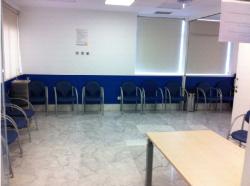Allergology
Facilities and equipment
Located on the first floor of building 3, it includes:
- 7 doctors' offices.
- 1 room for treating severe reactions.
- 1 administration desk.
- 5 laboratory rooms.
- 1 day hospital.
- 3 waiting rooms.
 High resolution image. This link will open using lightbox, there may be a context switch High resolution image. This link will open using lightbox, there may be a context switch |
 High resolution image. This link will open using lightbox, there may be a context switch High resolution image. This link will open using lightbox, there may be a context switch |
 High resolution image. This link will open using lightbox, there may be a context switch High resolution image. This link will open using lightbox, there may be a context switch |
 High resolution image. This link will open using lightbox, there may be a context switch High resolution image. This link will open using lightbox, there may be a context switch |
The available equipment includes, most notably:
- 5 Nasofibroscopes.
- 8 ENT examination lamps.
- 4 Spirometers.
- 4 Portable computerised spirometry monitors.
- 1 Pulse oscillometry device.
- 2 Ultrasonic nebulisers.
- 2 Pressure nebulisers.
- 3 Nasal endoscopy units.
- 1 Rhinomanometer.
- 1 Acoustic rhinometer.
- 4 Nasal peak flow devices.
- 10 Adult and child peak flows.
- 1 Optical microscope.
- Material for nasal cytology staining.
- Material for preparation of allergenic extracts.
- 1 Centrifuge.
- Examination tables in each room.
- Rhinoscopes.
- 2 Pulse oximeters.
- 1 O2 sat monitor, blood pressure, electrocardiograph.
- 1 Exhaled nitric oxide monitor.
- 1 Defibrillator.
- 1 Cardiopulmonary resuscitation cart.
- Oxygen, medical air and vacuum intakes.
- 4 Refrigerators.
- 4 Freezers.
- 1 Closed-circuit camera for nasal-bronchial provocation with powder.
- 1 7m3 Chamber for bronchial provocation with chemical products.
- 1 Device to perform eucapnic hyperventilation.
- 1 Monitor for isocyanates, chlorine and other chemicals.
- 1 Large-volume environmental sampler.
- 2 Low-volume environmental samplers.
- 1 Particle sampler.
- 2 Kits for qualitative and quantitative olfactometry.
- 3 Exhaled hydrogen meters.
- 1 CO2 meter.
- 6 Subcutaneous infusion pumps.
- 4 Intravenous infusion pumps.
- 8 Frick dermatograph pencils.
- 1 TempTest.
Services portfolio
Our portfolio is one of the most extensive in all the country. Services include sophisticated studies of rhinitis/sinusitis and asthma. Drug and food allergy studies are performed (including drug and food desensitisation protocols), mainly with milk and egg in children that are allergic. There is also a unit to study contact eczema and olfaction. We have a unique, benchmark unit in Spain to study occupational respiratory pathology and measure environmental allergens. We also have a full range of techniques for in vitro allergy studies, including molecular diagnostics.
Techniques
- Skin tests.
- Prick test with pneumoallergens.
- Intradermal reaction.
- Specific (food, medicines).
- Epicutaneous or patch (contact dermatitis) and occupational tests.
- Bronchial provocation tests.
- Non-specific (methacholine, adenosine, mannitol, hyperventilation, eucapnic, exercise).
- Specific with allergens.
- Oral provocation tests.
- Foods.
- Medicines.
- Desensitisation.
- Foods.
- Medicines.
- Lactose and fructose intolerance test.
- Parenteral provocation tests.
- Conjunctival provocation tests.
- Nasal provocation tests.
- Diagnostic study of physical and cold urticaria.
- Respiratory function tests.
- Acoustic rhinometry.
- Rhinomanometry.
- Peak nasal flow.
- Spirometry.
- Bronchodilation test.
- Pulse oscillometry.
- Exhaled nitric oxide measurement.
- Preschool function tests.
- Smell tests.
- Olfactometry.
- Induced sputum.
- Nasal Fiberoptic Endoscopy.
- Nasal cytology.
- Total IgE quantification.
- Determination and quantification of specific IgE antibodies by microarrays (molecular diagnostics).
- Basophil activation test.
- Determination and quantification of other antibodies.
- Determination of cytokines and other inflammatory mediators.
- Molecular biology studies.
- Detection and study of environmental samples.
- Study of complement system functions.
- Identification and characterisation of antigens.
- Preparation and standardisation of antigens.
Hospital Universitario Fundación Jiménez Díaz
Avda. Reyes Católicos, 2
28040 Madrid Madrid
© 2025 Quirónsalud - All rights reserved























